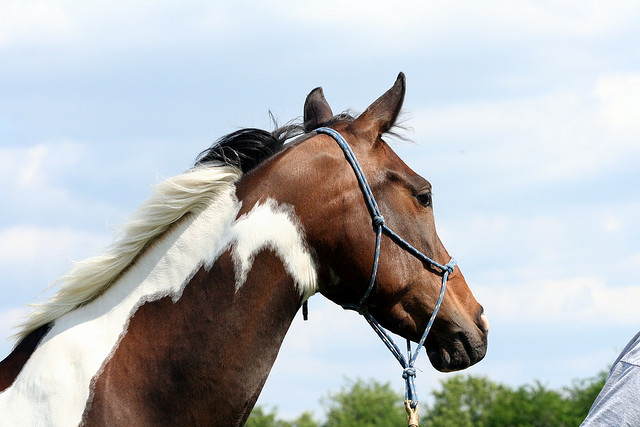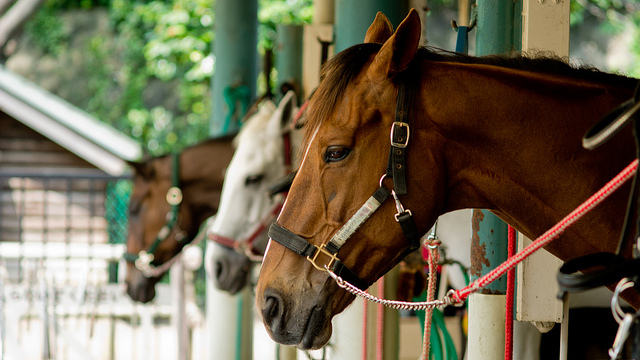Maybe you have worked with and around horses for most of your life, or perhaps you have simply owned the same horse for years. You are comfortable in your knowledge; safe in your comfort zone with that sense of security that only comes from familiarity and experience. You let your guard down, just a little, and cut a few corners to make things easier or faster…This is when it happens, the almost inevitable accident or incident that, if you are lucky, bruises only your pride.
Don’t feel bad, you’re not alone. I have spoken to countless horse trainers and experienced riders, and this level of security and almost “invincible” attitude that comes with being too comfortable for too long is something that touches all of our lives at some point. It is easy to forget that even though our horses are such a pleasurable and amazing part of our lives, they also have the potential to seriously injure us. I have chosen three real life stories (names have been changed to protect the guilty, in this instance) that illustrate how forgetting the basics of good horsemanship can have serious consequences.

(flickr/jdan)
1. Not Respecting The Back Legs
One of the first things that most of us learn as budding horsemen and horsewomen, is the proper way to respect our horse’s back legs. Horses kick, that is just a simple fact, and one well placed kick, especially by a shod horse, can do serious damage.
Donna has owned horses for most of her life. Her current mount, a pretty bay Thoroughbred gelding, has been with her for ten years, since he was a two year old. Donna and her horse compete in Eventing and spend a lot of time out on the trails and beaches of the Central Coast, and anyone who knows the pair will quickly say that they have a unique bond. Last summer, Donna was at the barn enjoying another beautiful day in paradise. She was chatting with a friend while her horse stood in the cross ties; almost on autopilot, she was brushing, checking legs and picking feet. At one point, she was standing behind her horse, doing a quick braid of his tail, when a bird flew through the rafters of the barn, and without warning, he kicked out and caught Donna squarely in the knee.
Donna was rushed to the hospital. Her knee was broken and she required two surgeries over a six month period. Just this spring, almost a year from the time that the accident occurred, Donna sat on her horse for the first time. She admits to being somewhat afraid, despite all of her years of experience, which is a sharp contrast to the brazen confidence she felt before the accident.
2. Proper Security
Most horses are pretty respectful of the gate or stall door. We lead them into their “houses”, or into the arena for turn out, and everything goes as planned. Eventually, we begin believing that our horses wouldn’t dare attempt an “escape” that requires them to go through us in order to get out. We leave stall doors and gates open or unlatched while we blanket, fill water buckets, fill feed bags, etc. On occasion, we may hold the arena gate closed with a foot while quickly unbuckling a halter…Whatever the shortcut, we have forgotten that, as a flight animal, a horse can feel the need to “flee” from something that he perceives as “scary” in a split second, and if we get in the way, we just might get run over.

(flickr/ysksmz)
Laura has shown horses on the NRHA circuit for over twenty years. Both of her horses are “hams”, and enjoy playing little games with each other and with Laura, but they are kind and sensible. At the last show of the season in 2013, Laura arrived to the showgrounds where she would be competing and was setting up her stalls and tack room. She put one horse into his stall and secured his gate before moving on to the second. She led him into the stall, slipped off his halter, and he immediately began munching hay from his hay bag. Laura realized that she hadn’t put his water bucket into the stall and it was sitting about five feet away near her trailer. Without latching the stall door, she simply took the two steps and reached for the bucket, but before she knew what was happening, she was knocked flat on her stomach, and her typically lazy and easy going horse was running loose down the barn aisle.
Laura was able to corner her gelding, but only after he had led her, and several other exhibitors and trainers, on a merry chase around the showgrounds. At one point, he ran directly at a small girl who was trying to help catch him and knocked her to the ground. It was a freak incident, and aside from a few small scrapes on the gelding’s lower legs, and Laura’s bruised pride, things worked out…but it could have turned out much differently.
3. Letting Go of the Reins
When you have been riding for years, certain little habits begin to surface. One that I see quite often is riders who mount and dismount their horses without keeping a firm hold on the reins. They are used to a horse that stands quietly, and it is such a common and comfortable maneuver that laying the reins over the neck and swinging up into the saddle, or down off of the saddle, isn’t given a second thought.
Tom is a well known and highly respected trainer who specializes in Reining horses. He works with young horses, problem horses, and finished horses on a daily basis, and competes successfully on the NRHA circuit. Early into his career, Tom was getting ready to work one of his favorite finished horses, who had been in his barn for over five years. This is a horse that he would put almost anyone on, as she was about as close to perfect as a horse could be in terms of attitude and predictability. Tom threw the reins over the little mare’s neck and quickly swung up into the saddle. Just as he was centering himself, a car backfired and the mare jumped straight into the air; the reins hit the ground, Tom caught her with his leg and she took about five canter strides before stepping on one of the reins and coming to a screeching halt. Tom was sent over the front of her neck and landed hard. A slight concussion and bruised tailbone put Tom out of the saddle for about a week. Worse, though, was that when the mare stepped on her reins, the bit sliced her mouth open and the wound required stitches. She healed, but it took months to get her comfortable in the bridle again.

These are just three stories out of hundreds that I have heard over the years, and I may have one or two of my own to add to the mix. These things can happen to all of us at any given time, no matter how much experience that we have or how well we know our horses. So, the next time that you’re out at the barn, be mindful of your routine, and make sure that you haven’t acquired any dangerous habits. The ultimate goal is to spend a happy lifetime in the saddle, and safety is always the first step.
Originally published at SLOHorseNews.net




 June 30, 2015
June 30, 2015 






















